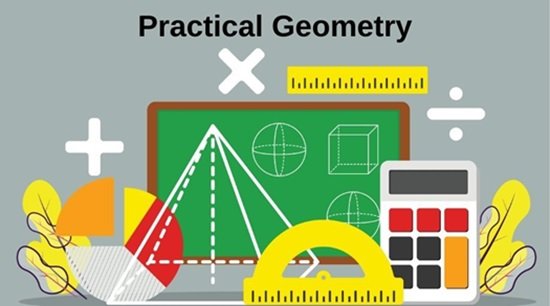
Chapter-14: Practical Geometry
CBSE Class 6 Maths Notes Chapter 14 Practical Geometry

Practical Geometry:
Practical Geometry, We use the following tools in drawing geometrical shapes:
- A graduated ruler
- The compasses
- The divider
- Set-squares, and
- The protractor.
In this chapter, we shall consider only “Ruler-and-compass constructions”.
Circle
Every point on the boundary of a circle is at an equal distance from its center.
We need to use compasses here.
A Line Segment
We need a ruler here.
Construction of a line segment of a given length
We have to use a ruler for this construction.
Constructing a copy of a given line segment
We may use a ruler or trace paper here. But it is better than we would use ruler and compasses for making, the construction.
Perpendiculars
Two lines or rays or line segments are said to be perpendicular if they intersect such that the angle formed between them is 90°.
Perpendicular to a line through a point on it
It may be drawn in three ways:
- by paper folding,
- using a ruler and a set-square, and
- using a ruler and the compasses.
Perpendicular to a line through a point not on it
Either of the three methods given below may be adopted:
- by paper folding,
- using a ruler and a set-square, and
- using a ruler and the compasses.
The perpendicular bisector of a line segment
There are three methods as given below:
- by paper folding,
- by using transparent tapes, and
- by using ruler and compasses.
Angles
Constructing an angle of a given measure
We use a ruler and a protractor here.
Constructing a copy of an angle of unknown measure
We use a ruler (or a straight edge) and the compasses.
Bisector of an angle
Two methods are possible:
- by paper folding
- by using ruler and compasses
Angles of special measures
There are some elegant and accurate methods to construct some angles of special sizes without using the protractor.
Some of such constructions are:
- Constructing a 60° angle
- Constructing a 30° angle
- Constructing a 120° angle
- Constructing a 150° angle
- Constructing a 90° angle
- Constructing a 45° angle
FAQs on Practical Geometry – Class 6 Maths
1. What is Practical Geometry?
Practical Geometry is the branch of geometry that deals with constructing geometrical shapes such as lines, angles, and polygons using tools like a ruler, compass, protractor, and set squares.
2. What tools are used in Practical Geometry?
The tools commonly used are:
- Ruler (scale)
- Compass
- Protractor
- Set squares
- Pencil
- Eraser
3. What are the basic constructions taught in Class 6 Practical Geometry?
The basic constructions include:
- Drawing a line segment of a given length.
- Constructing a circle with a given radius.
- Drawing perpendicular lines.
- Constructing an angle using a protractor.
- Constructing angles of 30°, 45°, 60°, 90°, and 120° using a compass.
- Bisecting a line segment or an angle.
4. How do you draw a line segment of a given length?
To draw a line segment of a given length:
- Place the ruler on paper.
- Mark two points on the ruler that correspond to the given length.
- Join the points using a ruler and draw a straight line.
- Label the line segment.
5. How do you construct a circle with a given radius?
To construct a circle:
- Take a compass and set its opening to the given radius using a ruler.
- Place the pointed end of the compass at the center of the circle.
- Rotate the compass to draw a complete circle.
6. How can you draw a perpendicular to a line from a point on the line?
To draw a perpendicular from a point on the line:
- Place the compass at the point and draw arcs on both sides of the point along the line.
- Keeping the same compass width, draw two arcs above the line from the two points where the first arcs meet the line.
- Join the intersection of the arcs to the point. This is the perpendicular line.
7. What is the method to bisect a line segment?
To bisect a line segment:
- Place the compass at one endpoint and draw an arc above and below the line segment.
- Without changing the compass width, repeat the same from the other endpoint.
- The arcs will intersect at two points. Join these points to bisect the line segment.
8. How do you construct an angle of 60° using a compass?
To construct a 60° angle:
- Draw a line segment and mark a point on it.
- Place the compass at the point and draw an arc intersecting the line segment.
- Without changing the compass width, place the compass at the point of intersection and draw another arc.
- Join the point of the line segment to the intersection of the arcs. The angle formed is 60°.
9. How can you bisect an angle?
To bisect an angle:
- Draw the given angle using a protractor or compass.
- Place the compass at the vertex of the angle and draw an arc that intersects both arms.
- From the two points where the arc intersects the arms, draw arcs that intersect each other.
- Join the vertex to the point of intersection of the arcs. This line bisects the angle.
10. Why is Practical Geometry important?
Practical Geometry is important because it helps students develop skills to construct accurate shapes and angles. It is widely used in real-life applications such as architecture, engineering, and design.




1 Comment